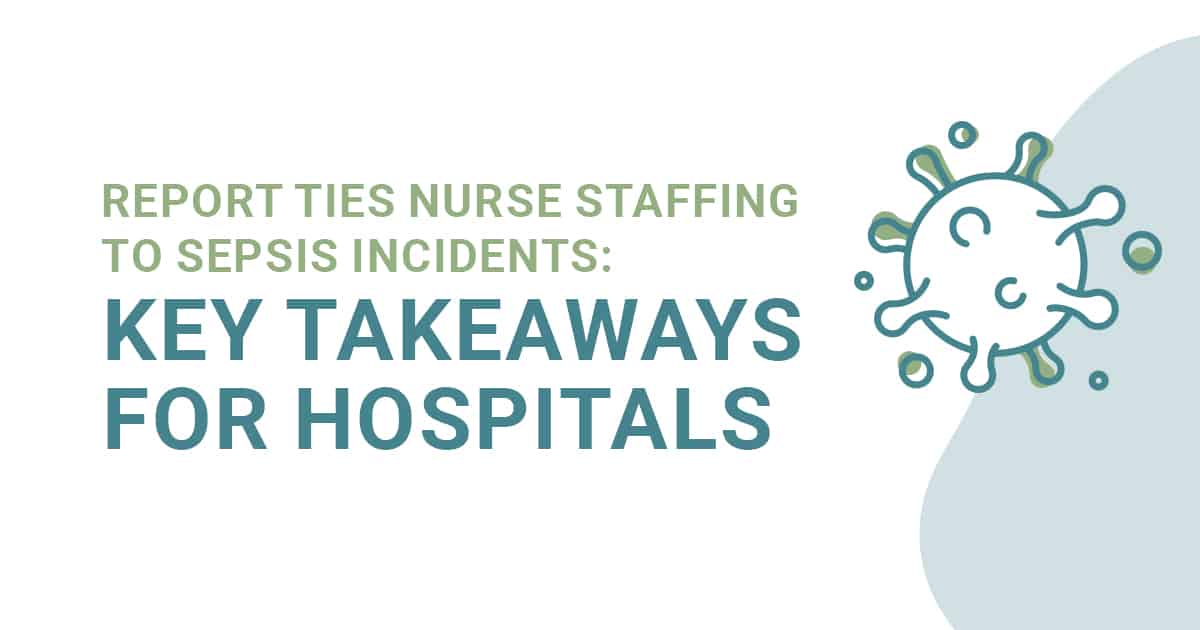New research shows that more nurses on the job means fewer sepsis deaths. Are you prepared to do what it takes?

The health care field grappled with unparalleled challenges during the COVID-19 pandemic. Of all health care providers, nurses have faced some of the greatest and most persistent obstacles — overtime demands, risks of illness and surly patients. All of the above have contributed to burnout and widespread staffing vacancies.
A new report shows those shortages have profound effects, beyond the obvious difficulties of keeping hospitals and doctors’ offices running.
Published in the May issue of the JAMA Health Forum, “Association of Registered Nurse Staffing With Mortality Risk of Medicare Beneficiaries Hospitalized With Sepsis,” outlines how the number of nurses on duty affects deaths from sepsis – that extreme, body-wide reaction to infection.
“Based on our analysis of hospitals and patients nationwide, the study findings suggest that nurse workload is an overlooked and underused aspect of the treatment bundle for patients with a diagnosis of sepsis,” researchers wrote while discussing the data.
Here are three main takeaways from the study and what they mean for you.
The numbers tell a clear and convincing story.
Mark Twain may have said there are three kinds of lies: lies, damn lies and statistics, but the results from the study were anything but vague and open to interpretation. They show beyond a doubt that survival from sepsis improves with more nursing care.
Victoria Bailey from RevCycle Intelligence pulled out some of the most noteworthy findings.
- The odds of 60-day sepsis mortality dropped by 3 percent for “each additional registered nurse hour per patient day.”
- If hospitals ensured that each patient day had at least six registered nurse hours, that could stop some 1,266 sepsis-related deaths.
- The benefits didn’t end there. More nurse hours meant more deaths prevented. Ratcheting up to eight nurse hours per patient day meant 4,306 fewer deaths.
The more nursing coverage you have, the more lives are saved. Those who would otherwise succumb to sepsis — and any number of other diseases and conditions — will walk out of the hospital happy and healthy. It’s that simple.
We’ve known the basics for some time.
Back in 2017, the Nurse.com blog pointed out that not only was sepsis an ongoing challenge for hospitals, but that nursing staff had a key role to play in saving lives. In addition, the Centers for Disease Control and Prevention had just launched a campaign to raise awareness and encourage treatment of sepsis.
“Healthcare professionals, patients and their family members can work as a team to prevent infections and be alert to the signs of sepsis,” said Lauren Epstein of the CDC’s Division of Healthcare Quality Promotion. “Get Ahead of Sepsis encourages healthcare professionals and patients to talk about steps, such as taking good care of chronic conditions, which help prevent infections that could lead to sepsis.”
A study conducted in 2020 by the Center for Health Outcomes and Policy Research (CHOPR) at the University of Pennsylvania School of Nursing backs up the research from the JAMA Health Forum article.
That research found that “each additional patient added to a nurse’s workload is associated with 12% higher in-hospital mortality from sepsis compared with only a 5% improvement in mortality associated with improved adherence to mandated care bundles.”
In other words, the trends are clear. So what do we do about them?
You have to face staffing shortages head-on.
At day’s end, multiple scientific studies and public information campaigns show that saving patients from sepsis comes down to the number of eyes on those patients and the number of bodies caring for them.
That means accepting the current staffing situation and possibly making tough decisions.
You might have to pay more. You might have to increase flexibility for workers. You might have to recruit from talent pools you previously overlooked. But, whatever you do, denying that you have the problem won’t make it better.
This is also a reason to ensure you have a knowledgeable partner who can advise you about minimizing risk to improve patient care and avoid malpractice claims. Med Law Advisory Partners has deep experience in the area, and that experience can help you as you grapple with the steps ahead.
“The data and trends identified through our claims reviews also provide a wealth of intelligence into an organization’s clinical operations,” Med Law says. “These valuable insights allow Med Law to guide healthcare leaders toward long-term operational enhancements through a strategic, upstream approach that integrates insights with their quality and patient safety agenda.”